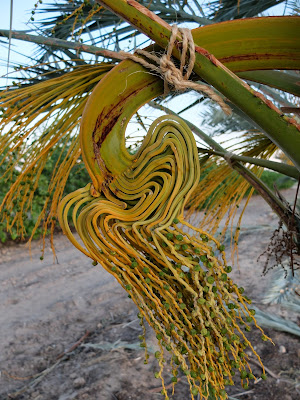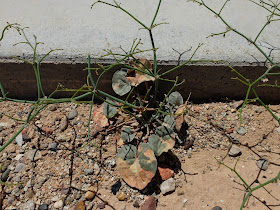Left: Thinned out inflorescence, notice spacing of green dates. Right: Inflorescence not yet thinned?


On this trip to the “valley”, we observed these plants:
[Aizoaceae] Sesuvium verrucosum - Western Sea-Purslane
From the Wikipedia entry: “It grows in many types of saline and alkaline habitat types on the coast and inland, including salt marshes and other saline wetlands, alkali flats, and drying desert washes.” Surprise!
[Amaranthaceae] Atriplex lentiformis - Quailbrush / Saltbrush
Plants in the genus Atriplex go by the common name of saltbush because many plants in the genus are halophytes, that is, plant adapted to growing in waters with high salinity. The ground where we observed most of these plants (Upper Imperial Valley) is quite alkaline.
[Amaranthaceae] Kali tragus - Prickly Russian Thistle,
Many plants may become tumbleweed, but this introduced plant in the Amaranth family is the most common.
[Arecaceae] Phoenix dcatylifera – Date Palm
Our fascination with the Data Palm continues (see Binomen Art – Phoenix) and we were able to examine some trees up close after workers had gone through and thinned dates. Date Palms are marginal halophiles.
[Fabaceae] Pithecellobium dulce – Guamuchil
We saw this tree while dining at the Garden Café in Yuma. This pea family tree produces pods that are a delicacy for those in the know. We only observed a couple of unripe pods, but still an impressive tree.
[Polygonaceae] Eriogonum deflexum - Wild Buckwheat, Skeletonweed
This plant is quite common. We happened to snap a photo of this one at the Museum of History in Granite in Felicity, California (in Imperial County). The plant looked very lonely amongst all the red granite panels.
[Lythraceae] Punica granatum – Pomegranate
A lonely P. granatum growing next to an abandoned satellite dish.
Left and Right: Atriplex lentiformis
Left: Trying to botanize in 50 mph gusts of dirt and sand! Right: One of many solar fields. This one doesn’t have panels yet.
Left: My lovely assistant launches a tumbleweed. Right: And then tries to outrun it.
Left: Tumbleweed (Kali tragus) in a check. Right: Pomegranate (Punica granatum) and satellite dish.
Date Palms (Phoenix dactylifera): Method of tying inflorescence to branches.
Guacmuchil (Pithecellobium dulce) pods and tree
Left: Guacmuchil (Pithecellobium dulce) flowers. Right: Eriogonum deflexum.


















No comments:
Post a Comment
All comments are moderated. If your comment doesn't appear right away, it was likely accepted. Check back in a day if you asked a question.